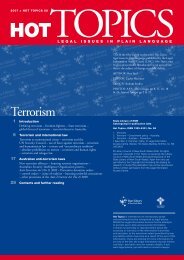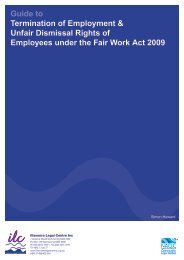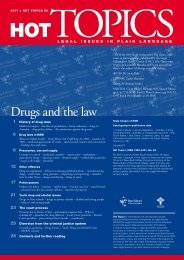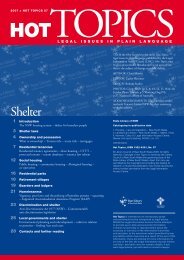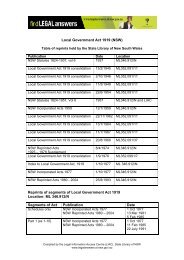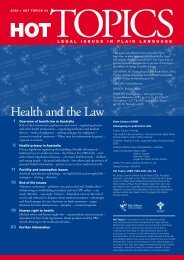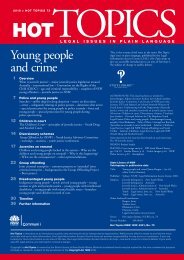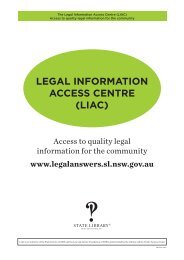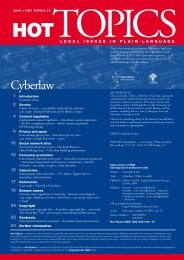Prisoners - Legal Information Access Centre - NSW Government
Prisoners - Legal Information Access Centre - NSW Government
Prisoners - Legal Information Access Centre - NSW Government
Create successful ePaper yourself
Turn your PDF publications into a flip-book with our unique Google optimized e-Paper software.
2. The Systemic Environment. A range of factors<br />
to do with the overall environment can ‘disrupt<br />
or impede the ability of inmates to address their<br />
legal needs’. These include: insufficient <strong>Legal</strong> Aid<br />
and PLS lawyers to meet the demands for services,<br />
especially in rural areas; custodial staff shortages; the<br />
frequency of lockdowns; reallocation of DCS staff;<br />
a shortage of welfare officers; no internet access (for<br />
security reasons); insufficient access to telephones;<br />
lack of access to courses (which may affect eligibility<br />
for parole); constant transfers of prisoners to other<br />
institutions; and the stress associated with transit<br />
to and from court (although this is being partly<br />
addressed by expanded audio visual links (AVL) (see<br />
Report: Chapter 7).<br />
3. Pathways and Intermediaries. ‘In the absence of an<br />
ability to act directly, inmates rely to a high degree<br />
on other people either to act on their behalf or to be<br />
a relay point in the process of preventing, identifying<br />
or addressing a legal problem.’ The intermediaries<br />
include custodial officers, welfare officers, library/<br />
education staff, inmate peers, and friends and<br />
family. Difficulties arise in identifying appropriate<br />
intermediaries and pathways to legal assistance;<br />
the fact that assistance was seen as a discretionary<br />
matter; delays; the development of a relationship of<br />
dependence; and variable quality in the information,<br />
advice and assistance provided by intermediaries (see<br />
Report: Chapter 8).<br />
4. Prison Culture can affect prisoners’ capacity and<br />
willingness to access justice. For example where an<br />
‘Us versus Them’ inmate code, sometimes referred<br />
to as ‘green’ (inmates’ uniform) v ‘blue’ (officers’<br />
uniform) is in force, reporting to prison authorities<br />
matters such as assault or sexual assault can be<br />
hazardous and lead to being stigmatised as a ‘dog’ or<br />
informer. This can cast suspicion over any approach<br />
to prison officers for assistance including with legal<br />
issues. Another aspect of culture is the acceptance of<br />
violence as integral to prison life and as a solution<br />
to conflict. The normalisation of violence leads<br />
to significant under reporting, trivialisation and<br />
‘rationalises a lack of resort to formal processes of<br />
legal redress’. Forms of inmate subjectivity, notions<br />
of being seen as ‘undeserving’, ‘criminal’ or ‘guilty’<br />
can operate to ‘validate prejudicial treatment’ and<br />
‘de-motivate the inmate to act on future legal<br />
issues’. Finally the formal culture of the prison<br />
encourages compliance and passivity in inmates<br />
which undermines the persistence, independence<br />
and skills required to face up to and resolve legal<br />
issues.<br />
prisOners And THe mediA<br />
Media treatment of prisons tends to fluctuate between<br />
sensationalist exploitation of public fears and fascination<br />
with notorious prisoners and their crimes, reformist<br />
critiques of prison conditions, and largely ignoring<br />
image unavailable<br />
Razor wire fence at Fremantle prison, WA.<br />
Roel Loopers.<br />
12<br />
HOT TOPICS 67 > <strong>Prisoners</strong>



